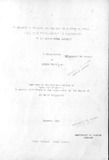| dc.description.abstract | Influence of Frequency and Intensity of Clipping on Forage Yield, Crude Protein Content and Digestibility of Six Kenyan Range Grasses. (December 1984)
Benson Mulwa Woie, B.S., Texas A&M University;
M.S., New Mexico State University Chairman of Advisory Committee: Dr. Joseph L. Schuster
This investigation was conducted at two experimental sites on the National Range Research Station, Kiboko, to evaluate forage yield, leaf-to-stem ratio, crown area, tiller number, regrowth height, forage digestibility, and crude protein content of six native range grasses following defoliation at three frequencies (3. 6, and 9 weeks) with three cutting heights to leave 5-cm, 10-cm, and 15-cm stubble heights.
Diqitaria macroblephara, Panicum maximum, and Cenchrus ci1iaris produced higher forage amounts and tiller number than Chloris roxbur- ghiana, Eragrostis superba , and Themeda triandra. The large number of tillers and leaf area produced by Digitaria macroblephara, Panicum maximum, and Cenchrus ciliaris, especially at the 6-week harvest frequency, allowed the three grasses to attain a maximum growth rate at an earlier age and recover soon after defoliation. Defoliation at the 3-week harvest frequency significantly suppressed tillering in all grasses and resulted in significant reductions in forage yield. Furthermore, plants defoliated at the 3-week interval with the 5-cm cutting height produced the lowest forage yield and tiller number.
Forage yield, tiller numbers, regrowth height, and crown area for
iv
the six grasses were highest at the 6-week harvest frequency and lowest at the 3-week harvest frequency. In contrast, leaf-to-stem ratio, crude protein content, and digestibility values were highest at the 3-week harvest frequency and lowest at the 9-week harvest frequency. Crude protein content and digestibility values of the leaf fraction were higher than crude protein content and digestibility values of the stem fraction. Furthermore, crude protein content and digestibility showed a decline for all grasses as the interval between defoliations increased.
Recommendations for further research include studying the responses of grazing animals and native range plants to a grazing plan that utilizes a 42-day defoliation frequency leaving stubble heights of 10 cm to 15 cm, and continuing to explore the impacts of defoliation treat- ments at various phenological stages on native range plants | |

